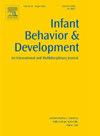When I move, you move: Associations between automatic and person-coded measures of infant-mother synchrony during free-play using virtual in-home data collection
IF 1.9
3区 心理学
Q3 PSYCHOLOGY, DEVELOPMENTAL
引用次数: 0
Abstract
The relationship between movement synchrony and global scores of behavioral synchrony were investigated during a naturalistic free-play between 33 infants (ages 12- to 24-months) and their mothers using a video-conferencing platform. We assessed movement synchrony by applying an automatic tool, motion-energy analysis (MEA), to the obtained video data. Dyadic movement synchrony was associated with higher levels of maternal sensitivity, infant involvement, dyadic reciprocity, and a child-led interaction pattern. This demonstrates the feasibility of using MEA as an automatic tool for assessing movement synchrony in mother-infant dyads and its application for investigating naturalistic at-home free play sessions in a remote setting.
当我移动时,你也移动:在使用虚拟家庭数据收集的自由游戏期间婴儿-母亲同步的自动和个人编码测量之间的关联
在视频会议平台上,研究了33名12- 24个月大的婴儿和他们的母亲在自然的自由游戏过程中,运动同步性和整体行为同步性得分之间的关系。我们通过对获得的视频数据应用自动工具运动能量分析(MEA)来评估运动同步性。二元运动同步与更高水平的母亲敏感性、婴儿参与、二元互惠和儿童主导的互动模式有关。这证明了使用MEA作为一种自动工具来评估母子二人组的运动同步的可行性,以及它在调查远程环境中自然在家自由游戏会话中的应用。
本文章由计算机程序翻译,如有差异,请以英文原文为准。
求助全文
约1分钟内获得全文
求助全文
来源期刊

Infant Behavior & Development
PSYCHOLOGY, DEVELOPMENTAL-
CiteScore
4.10
自引率
4.80%
发文量
94
期刊介绍:
Infant Behavior & Development publishes empirical (fundamental and clinical), theoretical, methodological and review papers. Brief reports dealing with behavioral development during infancy (up to 3 years) will also be considered. Papers of an inter- and multidisciplinary nature, for example neuroscience, non-linear dynamics and modelling approaches, are particularly encouraged. Areas covered by the journal include cognitive development, emotional development, perception, perception-action coupling, motor development and socialisation.
 求助内容:
求助内容: 应助结果提醒方式:
应助结果提醒方式:


